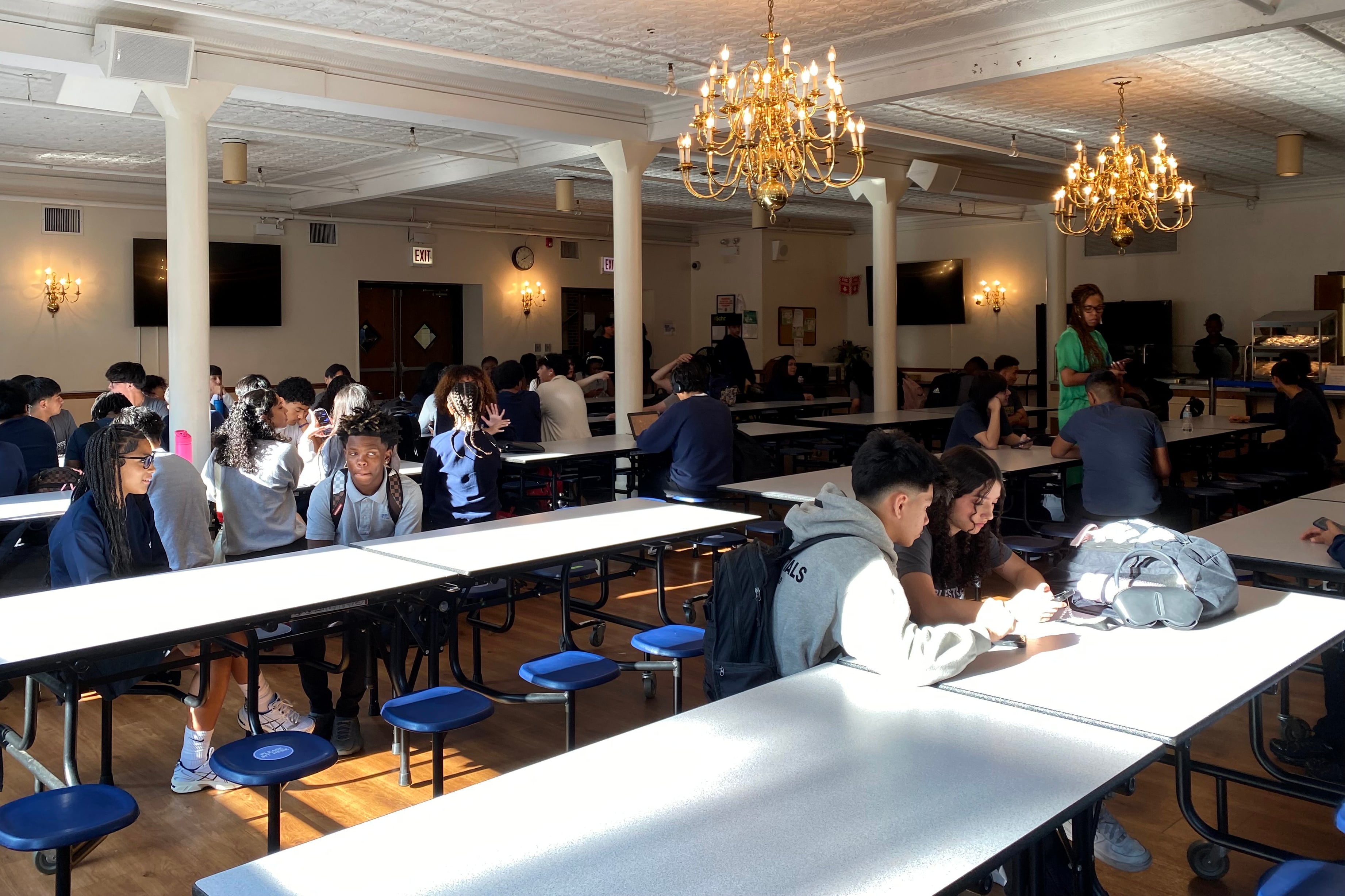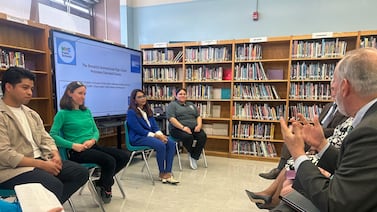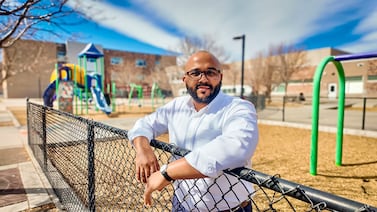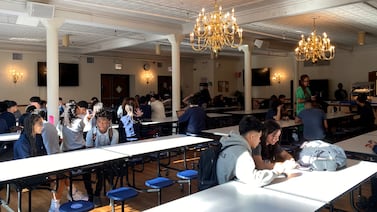Sign up for Chalkbeat Chicago’s free daily newsletter to keep up with the latest education news.
Micha Thurston, a teacher at Octavio Paz Elementary School, was recently collecting funds for field trips and other activities when a student asked her what the money was for. Thurston explained it was part of a school fundraiser. The student gasped.
“So we can stay open?” the student asked.
Paz, an Acero charter school on the Southwest Side, is slated to close by the end of the school year.
“And I said, ‘No, so we can give you the best school year we can give you,’” Thurston said. “She just looked so confused.”
Paz is one of two Acero schools closing by the end of this year. Another charter middle school — ASPIRA-Haugan — will also shut its doors for good. These three closures come after nearly a dozen charter campuses in Chicago ended operations over the past five years, with at least half of those tied to financial problems and enrollment declines. And, in a first, Chicago Public Schools plans to convert five Acero campuses into district-run elementary schools by fall 2026.
These closures and conversions of charter schools in Chicago mark a shift in the district’s approach to governing these privately-run, publicly-funded schools, which have existed since 1997. Though charters grew rapidly over the past 20 years, operators are facing declining enrollment, tighter budgets, and a 21-member, partially-elected school board with few charter allies.
Now, the relatively new school board is proposing changes to how it handles charter oversight. A resolution on Thursday’s meeting agenda would impose new requirements on operators and is already being opposed by the Illinois Network of Charter Schools, a special interest group that lobbies on behalf of charter schools.
The proposed resolution would, among other new stipulations, require operators to give the district 18 months notice of closing a school and assume financial responsibility related to the closure. It also calls on the district to lobby state lawmakers to change state law to stop charters from closing during their renewal term.
It comes as 21 charter schools — and the thousands of students they serve — have been in limbo this year as the school board delayed its vote on their renewals. While that has historically happened in January, the board pushed back its decision to this month.
As the district stares down a growing deficit, several questions about charter schools lie ahead for the board: Should the district absorb charter schools that networks decide to close — or should it allow the campuses to phase out? Should it work harder to enroll kids from closing charters at district-run schools that have long suffered from declining enrollment — or would that infringe upon family choice?
Elizabeth Todd-Breland, who was vice president of the Chicago Board of Education under Mayors Lori Lightfoot and Brandon Johnson and was more critical of charters than her predecessors, said deciding a path forward for how the district manages charter schools directly impacts students, their families, and educators.
She noted that charters grew rapidly under Renaissance 2010, an initiative under then-Mayor Richard M. Daley that led to the opening of 100 new schools, many of which were charters. By the time most of those schools opened, CPS’s enrollment growth had slowed and would ultimately start dropping.
Board members “also have to grapple with the realities of past and ongoing policies that have set up a school system that doesn’t work for everyone,” said Todd-Breland, an associate professor of history at the University of Illinois at Chicago. “How to find our way out of that as a city … is just really difficult.”
CPS spokesperson Quan Vu said in a statement the board’s decision to absorb the Acero campuses “to minimize disruption for affected students and families” shouldn’t be seen “as setting a precedent for how the district will handle future charter school closures.”
Could more charters become district-run schools?
Given the current mayor’s own critical views on charters in the past, many expected the first board appointed under Johnson to take a harder look at the charter sector.
The new board is made up of 11 of his appointees, plus four other allies. In November, during the first historic school board election, four people backed by the Illinois Charter Schools Network won.
But in an unexpected twist, after the Acero charter network decided to close half of its campuses, the Board of Education voted in February to save five of the seven Acero schools slated for closure and committed to financially support the schools through next school year, while also committing to turn them into district-run schools. That vote came after months of protests from families and the Chicago Teachers Union, which represents staff at Acero.
The vote raised a key question: Will other charter operators who are in trouble expect the cash-strapped district to provide a financial lifeline?
Elected school board member Yesenia Lopez, whose district includes some of the Acero schools, voted to save the five campuses by converting them to district-run schools. She said it was the right way to settle a deeply complicated problem. In an op-ed published Wednesday in the Chicago Sun-Times, Lopez wrote that the Acero situation caused “stress, heartache and uncertainty” for families and that charters should be required to notify the public at least a year in advance of closing a school.
“If a charter wasn’t up front about the financial situation or whatever the cause might be and they’re considering closure of schools, at least for myself, the families are the ones left hanging and scrambling,” Lopez told Chalkbeat.
Lopez said she feels that some charter networks fail to have meaningful engagement with families. With Acero, Lopez said she heard from multiple parents who felt confused about what comes next and that the network was uninterested in their feedback.
Acero has previously said it made one-on-one informational sessions available to families to explain their options moving forward.
But another elected school board member, Jennifer Custer, voted no. She supported saving the schools but worried about language that committed the district to absorbing the five elementary campuses after next school year. She supported a version of the resolution that would have allowed the district to consider whether it was viable to take over the campuses, rather than commit to that.
“We have to understand that this is a vote between making a financially responsible decision that doesn’t have greater effects across the district and saves some of these schools, or keeping these schools open at the cost of teacher and staff jobs in millions of dollars across the entire district,” Custer said before casting her vote.
CPS came close to taking over two charter high schools a little over a year ago. The school board voted to revoke the charter agreement with the once-nationally-lauded Urban Prep Charter Academy for Young Men after financial mismanagement, problems with serving students with disabilities, and allegations of misconduct against the organization’s former leader Tim King, which he has denied.
The plan was for CPS to turn the high schools into district schools.
But Urban Prep launched a legal battle that involved the state and the courts. Ultimately, an appeals court ruled that CPS had the right to close the school, which was set to happen by the end of this school year.
However, the district is recommending a two-year renewal for Urban Prep with several conditions, providing those families certainty for at least the next two years just months before the expected closure, according to the agenda for Thursday’s meeting.
For Thurston at Octavio Paz, amid the uncertainty of the past several months, students she works with have asked frequently about the school’s closure, she said. She said she can see the detrimental impact of Paz’s closure already, with some kids wondering why they’re bothering to come to school at all. And she’s unsure about her future, too.
The impact of closures on kids and families is why board member Jitu Brown, who voted to save the Acero schools and turn them into district campuses, said he doesn’t believe in closing charters even though he’s critical of the charter sector.
“That might mean absorbing them when they close, or it can mean them getting their act together, but what we have to have is accountability to the public,” Brown said. “You can’t just have the Wild Wild West in regards to schools operating in our community and being able to pick and choose their children, or not serve particular populations, or just shut down when it becomes less profitable.”
Timeline for charter renewals a moving target this year
In Illinois, charter schools must be run by nonprofits and operate in accordance with an agreement approved by a local school board. Only if a local board denies a charter applicant, can the operator appeal to the state for authorization.
Most of the state’s charters are in Chicago and are overseen by Chicago Public Schools. The school board decides whether contracts should be renewed and under what conditions.
At one time, that process in CPS would happen around November and December, according to Andrew Broy, president of the Illinois Network of Charter Schools. It shifted to late January during the last two school years before this year’s delay.
When it comes to financial oversight, the district doesn’t get audits from one school year until the following fall, said Hal Woods, the former head of the CPS’s office that oversees charter schools and current chief of policy at Kids First Chicago, an education advocacy organization.
“A school could be deep in financial trouble before CPS has the full picture,” Woods said. “Even when a school is placed on financial remediation, it has up to two years to course correct before CPS could step in to close it — if they act at all.”
The result, often, can be an abrupt decision from charter operators or the district to close campuses in a matter of months. Broy, however, argued that if charters had a better relationship with district leaders, then they could work together to figure out a solution for financial or enrollment issues.
The board’s proposed resolution on Thursday’s agenda would require the district office in charge of charter oversight to conduct annual site visits and provide school board members with copies of the rubrics used to evaluate charter school performance.
Another issue is the length of renewals, Broy said. His organization lobbied the state legislature to allow charters to be renewed for up to 10 years from their local school boards. That’s never happened in Chicago. But a handful of operators did get seven-year renewals prior to 2019. For the past several years, the school board has not renewed networks for more than five years and has done more one- or two-year renewals.
Broy is advocating for at least minimum three-year renewals this year. The district is recommending between two- and four-year renewals this year for 21 schools. About half are slated to receive two-year extensions, according to Thursday’s agenda.
“They look at charter schools and say, ‘How do we hold them accountable?’ They look at district schools [and say], ‘How do we support them?’” Broy said. That’s a sign the board “is not oriented towards helping charter schools prosper, helping the students in them grow. It’s oriented towards holding schools accountable, which is really a thinly veiled critique of the model itself.”
Still, Todd-Breland said, the renewal process is “often the only point of real accountability” for charters because they operate independently and don’t have other check-in structures that district schools do, such as network offices.
Vu, the CPS spokesperson, said the district uses shorter renewal terms “to promote accountability” and encourage operators to improve outcomes at their schools.
“These shorter terms allow for quicker adjustments in strategy, while ensuring operators remain responsive to the needs of students and communities,” Vu wrote in a statement.
Charters serve more than 50,000 students, but enrollment is dropping
Over Lori Cannella’s two decades at ASPIRA-Haugan Middle School, the health care worker-turned-teacher has seen the enrollment drop from about 500 students to about 80 this year.
The enrollment drop — in part due to new CPS middle school grades nearby and fewer families having kids — led to financial constraints and cuts in music and computer classes, Cannella said.
Then, just before winter break, the network’s leadership sat Haugan’s staff down and told them the school will close at the end of this school year.
The ASPIRA board voted in January to close the Haugan campus because of enrollment declines and financial issues.
ASPIRA board members did not return a request for comment.
Just as enrollment has dipped in district schools, the same has happened at charters, though at a lesser rate.
Charter enrollment in Chicago began falling after the 2015-16 school year, later than the district’s student count began to shrink, according to enrollment data provided by CPS. Since then, charters have seen a 14% drop in students and district schools saw a 17% dip.
The reasons for decreasing enrollment vary, including falling birth rates and dropping city population.
The district changed its budget formula to help protect against these enrollment shifts: Now, instead of basing funding on the number of kids in a building and increasing those funds based on need, the district guarantees certain staff positions to all schools, plus some discretionary funding. Schools with more pressing needs are allocated more positions.
But charters are still largely funded based on the number of students they’ve enrolled. State law requires the district to fund charter schools proportionally to per pupil funding at district-run schools. But generally, fewer kids at charters will mean less funding.
Board of Education member Brown believes more funding could help relieve the district of the thorny questions they face. He said he and other board members are advocating with the state to provide more funding to CPS and relieve it of costs that other districts don’t cover, such as teacher pensions.
But with fewer students overall, the district and its charter schools will continue to grapple with the challenges associated with operating schools with low enrollment.
Back at ASPIRA-Haugan, Cannella said she doesn’t see any hope the closure decision will be reversed. She now worries about how her sixth and seventh grade students will adjust to new teachers and classmates during the already challenging middle school years.
Reema Amin is a reporter covering Chicago Public Schools. Contact Reema at ramin@chalkbeat.org.






